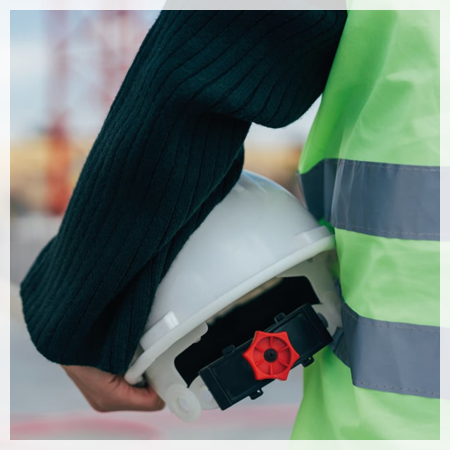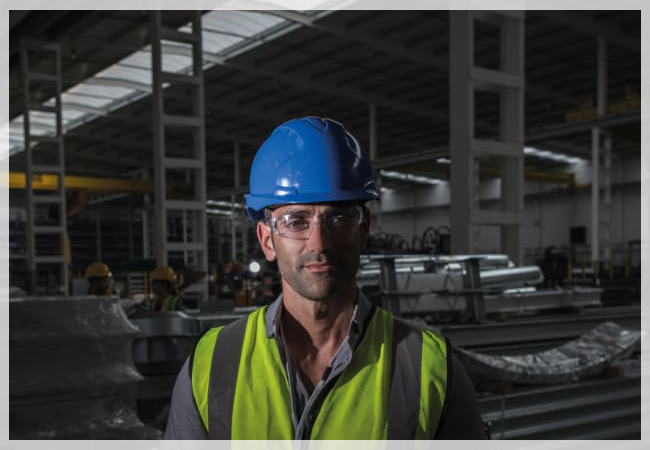Currency
March 25, 2018

In the workplace, workers are exposed to different kinds of hazards and as per the risk control hierarchy different control measures are in place. In the hierarchy of risk control, personal protective equipment takes the lowest priority, as it protects only the wearer and it will not completely remove the hazard from the hot spot. The role of PPE in offering above the neck protection, however, is incredible as it is one of the best options to protect against head impacts, eye injuries, hearing damage as well as respiratory hazards.
The credit for the above neck protection is always higher as it protects the human body’s important organs like the brain, ears, and eyes. So, the selection of above the neck protection is a very crucial task and needs detailed risk assessment. During those assessments, along with the existing hazards, the quality and comfort level of this PPE is to be considered. The legal norms have clearly mentioned that suitable personal protective equipment shall be provided and maintained by the employer, without cost to the workers and proper training should be provided for its proper use. The PPE should comply with standards and it also has to satisfy ergonomic principles. It is the responsibility of the worker to take care of the personal protective equipment. In this article, the importance of above the neck protection risk assessment and the corresponding PPE working principles are discussed.
Understanding above the neck protection Selection of PPE has to be made after the assessment has been completed successfully and choices are made depending on the period of use of the equipment, frequency and period of exposure to risks, scope and type of risks, specific characteristics of the workplace, processes and the type of activity, wearer comfort and performance characteristics. After assessing the risk, once the appropriate neck protection PPE has been identified, then the appropriate information should be given to the workers, such as PPE usage, the method of storage, cleaning requirements, the disposal procedures of contaminated PPE like used RPE cartridges, and the method of identifying damage and defects. Along with the instructions, specific training should also be provided.

Head protection is designed to protect the workers from falling items, hitting or bumping into items, as well as items that could swing, topple over or fly off, not to mention being caught by moving or rotating parts of work equipment or other items. Respiratory protection would be used if there is risk of inhaling hazardous substances and when oxygen content is below 15 vol%. Eye protection and face protection mitigate injuries from dusts, chippings, splinters or grains, optical radiation, being blinded by light, chemical hazards caused by solid, liquid or gaseous substances, infrared radiation, microorganisms, electric arcs and photokeratitis. Ear protection, when used correctly, prevents work induced hearing damage.
The brain can be injured by head trauma. Helmets designed to handle major crash energy generally contain a layer of crushable foam. The criteria for head protection are to resist penetration by objects, absorb the shock of a blow, be water resistant, and slow burning. A helmet should have a strong strap and be designed to encourage a good fit. If any heavy load hit a hard surface, the foam part of a helmet crushes and controls the crash energy, reducing the peak impact to the brain.
Rotational forces and internal strains are likely to be reduced by the crushing. Less dense foam can be better as well, since it can crush in a lesser impact, but it has to be thicker in order to avoid crushing down in a harder impact. The primary classifications of helmets are single-impact helmets. They are designed to absorb the energy of a single serious crash but must then be replaced. They are mostly suitable for road biking, most types of off-road biking, skiing and snowboarding. Multiimpact helmets, on the other hand, can absorb the impact of several crashes. This category is relatively new. They spread the impact across a larger area. If the helmet is very thick, the outer circumference of the head is in effect extended. In helmets a smooth plastic skin holds the foam together as it crushes and helps it skid easily on the crash surface, rather than jerking to a stop. In activities that involve forward speed on rough pavement, rounder helmets are safer, since they skid more easily. The straps keep the helmet on your head during the crash sequence. A helmet must fit well and be level on your head for the whole head to remain covered after that first impact. Helmets designed for lesser impacts do not necessarily have foam inside. Some are just hard shells with a suspension headband that provides the fit and keeps some space inside for air to circulate. Helmets used in the construction industry are of this type, and protect well when a brick drops over head or the head hits against an overhanging steel beam. Some foams in helmets are crushable and do not ever recover. In a bike helmet made with the expanded polystyrene foam, for example, the foam is trashed and cannot be reuse again. Butyl nitrate foam will recover slowly after a blow and can be reused. Construction helmets can be reused as long as the shell is not cracked and the suspension is not damaged. Safety helmets do have limitations, however, as they can protect the brain in a fall, but may not completely prevent serious harm. A helmet only protects what it covers, so for additional safety chin and jaw protection can be added if needed by using full-face helmets. A helmet must fit properly to have a chance of being effective.
The credit for the above neck protection is always higher as it protects the human body’s important organs like the brain, ears, and eyes. So, the selection of above the neck protection is a very crucial task and needs detailed risk assessment. During those assessments, along with the existing hazards, the quality and comfort level of this PPE is to be considered. The legal norms have clearly mentioned that suitable personal protective equipment shall be provided and maintained by the employer, without cost to the workers and proper training should be provided for its proper use. The PPE should comply with standards and it also has to satisfy ergonomic principles. It is the responsibility of the worker to take care of the personal protective equipment. In this article, the importance of above the neck protection risk assessment and the corresponding PPE working principles are discussed.
Understanding above the neck protection Selection of PPE has to be made after the assessment has been completed successfully and choices are made depending on the period of use of the equipment, frequency and period of exposure to risks, scope and type of risks, specific characteristics of the workplace, processes and the type of activity, wearer comfort and performance characteristics. After assessing the risk, once the appropriate neck protection PPE has been identified, then the appropriate information should be given to the workers, such as PPE usage, the method of storage, cleaning requirements, the disposal procedures of contaminated PPE like used RPE cartridges, and the method of identifying damage and defects. Along with the instructions, specific training should also be provided.

“personal protective equipment must be provided and maintained by the employer, and proper training should be provided for its proper use”
Head protection is designed to protect the workers from falling items, hitting or bumping into items, as well as items that could swing, topple over or fly off, not to mention being caught by moving or rotating parts of work equipment or other items. Respiratory protection would be used if there is risk of inhaling hazardous substances and when oxygen content is below 15 vol%. Eye protection and face protection mitigate injuries from dusts, chippings, splinters or grains, optical radiation, being blinded by light, chemical hazards caused by solid, liquid or gaseous substances, infrared radiation, microorganisms, electric arcs and photokeratitis. Ear protection, when used correctly, prevents work induced hearing damage.
HEAD PROTECTION
The brain can be injured by head trauma. Helmets designed to handle major crash energy generally contain a layer of crushable foam. The criteria for head protection are to resist penetration by objects, absorb the shock of a blow, be water resistant, and slow burning. A helmet should have a strong strap and be designed to encourage a good fit. If any heavy load hit a hard surface, the foam part of a helmet crushes and controls the crash energy, reducing the peak impact to the brain.
Rotational forces and internal strains are likely to be reduced by the crushing. Less dense foam can be better as well, since it can crush in a lesser impact, but it has to be thicker in order to avoid crushing down in a harder impact. The primary classifications of helmets are single-impact helmets. They are designed to absorb the energy of a single serious crash but must then be replaced. They are mostly suitable for road biking, most types of off-road biking, skiing and snowboarding. Multiimpact helmets, on the other hand, can absorb the impact of several crashes. This category is relatively new. They spread the impact across a larger area. If the helmet is very thick, the outer circumference of the head is in effect extended. In helmets a smooth plastic skin holds the foam together as it crushes and helps it skid easily on the crash surface, rather than jerking to a stop. In activities that involve forward speed on rough pavement, rounder helmets are safer, since they skid more easily. The straps keep the helmet on your head during the crash sequence. A helmet must fit well and be level on your head for the whole head to remain covered after that first impact. Helmets designed for lesser impacts do not necessarily have foam inside. Some are just hard shells with a suspension headband that provides the fit and keeps some space inside for air to circulate. Helmets used in the construction industry are of this type, and protect well when a brick drops over head or the head hits against an overhanging steel beam. Some foams in helmets are crushable and do not ever recover. In a bike helmet made with the expanded polystyrene foam, for example, the foam is trashed and cannot be reuse again. Butyl nitrate foam will recover slowly after a blow and can be reused. Construction helmets can be reused as long as the shell is not cracked and the suspension is not damaged. Safety helmets do have limitations, however, as they can protect the brain in a fall, but may not completely prevent serious harm. A helmet only protects what it covers, so for additional safety chin and jaw protection can be added if needed by using full-face helmets. A helmet must fit properly to have a chance of being effective.









